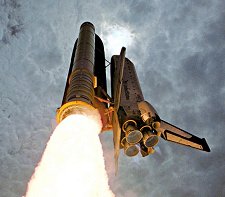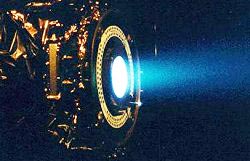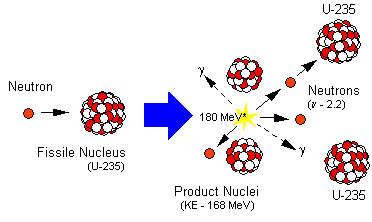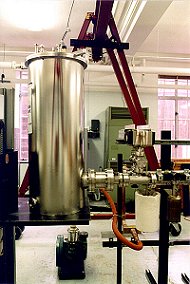|
Scientists ponder the question, "What advances
in power technology are required to send human and robotic explorers
throughout the solar system?"
by Linda Voss
Beyond all the planets in our solar system
in a cold, dark, empty region of space, Voyager 1 continues its 25-year
journey of exploration. It's headed for the heliopause, that boundary
where the Sun's influence ends and the dark recesses of interstellar
space begin. From where Voyager sits, the Sun is merely the brightest
star in the sky - seven thousand times dimmer than we see it from
Earth.
Voyager doesn't have any solar panels; they wouldn't do any good
so far from the Sun. The probe stays in touch by carrying its own
power source, an early radioisotope thermoelectric generator (RTG),
which converts the heat generated from the natural decay of its
radioactive fuel into electricity. Its RTG will supply Voyager with
electricity at least until 2020.
Space probes that travel much beyond Mars need more power than
solar cells can provide. Another example is the Ulysses spacecraft.
It was launched in October 1990 from the space shuttle on a mission
to study the Sun's poles. To get above the Sun, Ulysses had to fly
around Jupiter and slingshot out of the plane of the planets. Near
Jupiter, the Sun's rays are 25 times weaker than near Earth. Solar
panels large enough to catch this weak energy would have weighed
1,200 pounds, doubling the weight of the spacecraft and making it
too heavy for booster rockets from the shuttle. Instead, Ulysses
was equipped with an RTG weighing only 124 pounds. It easily powers
all the probe's onboard systems, including navigation, communication
and scientific instruments.

375 km
above Earth's surface, solar arrays power the orbiting International
Space Station.
|
A probe like Ulysses needs a couple
of hundred watts of power to operate onboard systems. For comparison,
the shuttle's onboard systems use 5 to 10 kilowatts (kW) of power,
50 times that. The International Space Station (ISS) uses 10 times
more, or about 100 kW for onboard systems.
The ISS never leaves Earth orbit, which
reduces the power it needs. Human missions beyond Earth's neighbourhood,
however, will require power not only for onboard systems, but also
for propulsion and for systems to support humans when they arrive
wherever they're going. "To pursue ambitious human missions across
the solar system, perhaps returning to the Moon, perhaps going on
to Mars, will require hundreds to a thousand kilowatts on the surface
and hundreds to thousands of kilowatts for transportation systems,"
says John Mankins, chief technologist for the Advance Systems Program
at NASA headquarters. You can't just plug into the nearest electrical
outlet, he added. You have to bring your own power source. Ideally,
you'd like to find something that could provide power for both propulsion
and operations.

Chemical
rockets propel the space shuttle away from Earth.
|
Since Robert Goddard's first test launch of
a rocket in 1916, space missions have used chemicals to get the
acceleration needed to escape Earth's gravity. A rocket's 5- to
15-minute burn sends the spacecraft towards its destination; then
it coasts the rest of the way unless it uses the gravity of other
planets for an additional boost. For Voyager, it took years to reach
Saturn and then the spacecraft was only able to spend days in the
Saturn system and only hours near the planet itself.
Mission planners would like to do better in
the future.
From the perspective of the Exploration
Office at the Johnson Space Centre, Jeff George sees "an evolving
family of related power and propulsion technologies" for the next
wave of human exploration. The first likely candidate is electric
propulsion (EP). You don't need as much thrust in space as you do
to escape Earth's gravity, explains George, but you do need to produce
thrust using very little fuel because of weight restrictions. Electric
propulsion could provide fuel-efficient thrust after an initial
chemical boost into space.
Specific impulse - that is, the pounds of thrust
produced per pound of propellant used per second - is a measure of
the efficiency with which a system uses fuel to produce thrust.
Higher is better. The space shuttle, which stays near Earth, uses
chemical propulsion with a specific impulse of 450 seconds or 450
pounds of thrust for a pound of propellant per second. EP has 10
times the specific impulse of chemical propulsion and potentially
can go as high as 10,000 seconds.

The ghostly blue exhaust of Deep Space 1's ion
propulsion engine. Power collected from the craft's solar
arrays is used to ionize atoms of xenon. As these ions are
expelled by a strong electric field out the back, the spacecraft
slowly gains speed.
|
EP got its first try in 1998 on Deep Space 1 - a
spacecraft that tested many new technologies before it flew by comet
Borrelly in 2001. Deep Space 1 needed 2.5 kW to power both its electric
ion propulsion drive (pictured left) and other onboard systems.
The energy came from an innovative collector consisting of advanced
solar cells and a lens to concentrate sunlight on the panels. Together
they achieved a 23% efficiency in converting sunlight to electricity
compared with 14% efficiency for the solar arrays on the ISS.
Building on the success of Deep Space 1, a new
mission named "Dawn" will leave Earth in 2006. Propelled by an ion
engine with a specific impulse of 3100 seconds, Dawn will travel
to Ceres and Vesta, two of the biggest asteroids in the solar system.
Although Ceres and Vesta lie farther from the Sun than Mars does,
the spacecraft will be able to draw all the power it needs from
7.5 kW solar arrays.
Manned missions need more power. "The next step
for a [human-crewed] Mars mission," says Jeff George, "is to step
up to 5-10 megawatts of nuclear power and then scale up the electric
thrusters to megawatts per engine." Going from kilowatts to megawatts
is not a simple problem. NASA is now working on a 5-10 kW next-generation
ion propulsion system. George envisions small, nuclear-electric
vehicles of 100-200 kW exploring the outer planets as a pilot version
of the megawatt scale they'd like to use for human exploration.
To run a megawatt EP system, you need a source
with both high energy and high power. As John Cole, manager of the
Revolutionary Propulsion Research Project Office explained, "Energy
is the most important factor, but power (the energy released per
unit time) determines acceleration." So what source provides enough
power? "Nuclear has plenty of energy - and potentially plenty of
power, too," Cole observes. "Solar panels provide insufficient power
for the entire vehicle to accelerate to levels that permit short
trip times."

Fission,
the same atom-splitting process that energizes modern nuclear
power plants, is one way to generate high levels of power
to propel spaceships.
|
Radioisotope power sources (like the RTGs onboard
Voyager) give off a lot of energy over a long period of time, but
not a lot of power, only tens to hundreds of watts. To get kilowatts
to megawatts of power, you have to go to nuclear fission, says Les
Johnson, of NASA's Advanced Space Transportation Program.
Fission, in which a neutron splits an atom into
two radioactive isotopes, is the process nuclear power plants on
Earth use to produce electricity. "Bringing along a fission reactor
on a spacecraft would be like bringing along your own [mini] power
plant," says Johnson. A fission reactor is capable of fueling high-performance
electric propulsion beyond the inner solar system. It is longer
duration and power rich for performing sophisticated scientific
investigations, high-data rate communications, and complex spacecraft
operations.
That's a pretty good resume for fission, but
it still doesn't pass John Cole's test. Cole set himself the requirement
of getting humans to the outer planets in a year and back in a year.
Nuclear fission has enough energy, but not enough power to provide
the acceleration needed. NASA is designing a 300-kW flight configuration
system using nuclear fission. But to meet Cole's test, "one needs
a very high specific power, power per unit mass vehicle three orders
of magnitude better than what we've currently planned for nuclear
fission." For that, you have to step up to nuclear fusion - the same
process that powers the Sun and stars.

more
Go out
at night and look at the sky. Every star you see is a fusion
reactor. Scientists would like to harness such power to
propel spaceships and energize distant colonies.
|
Fusion, which releases energy by combining rather
than splitting atoms, could in principle supply gigawatts of clean
power. However, fusion propulsion systems as we understand them
today would be very big, requiring a vehicle the size of the space
station or Battlestar Galactica, weighing hundreds of tons - although
the size might come down with research.
Fusion engines would be very efficient fuel
burners with a specific impulse of 100,000 seconds. "Though
we couldn't do it in 10 years, if we could launch a fusion propulsion
system 10 years from now, we could send a vehicle out to catch Voyager
and bring it back," says Cole. That kind of power and speed shortens
the time that astronauts would be exposed to harmful cosmic radiation
and the bone loss that comes from prolonged weightlessness.
Perhaps there's something even better than fusion:
A thruster powered by matter-antimatter annihilation would have
a specific impulse of 2,000,000 seconds, according to Cole.

more
This "Penning
trap" developed at Penn State University stores antiprotons.
|
It sounds like science fiction, but researchers
are learning to create and store small amounts of antimatter in
real-life labs. A portable electromagnetic antimatter trap at Penn
State University, for example, can hold 10 billion antiprotons.
If we could learn how to use such antimatter
safely, we could impinge some on a thin stream of hydrogen gas to
create thrust. Alternatively, a little antimatter could be injected
into a fusion reactor to lower the temperatures needed to trigger
a fusion reaction.
"Propulsion isn't the only reason to
go nuclear," notes Colleen Hartman, director of solar-system exploration
at NASA. "Onboard systems benefit, too. The excess power is like
getting the Las Vegas strip instead of a single light bulb. It gives
you greater communication and mission flexibility."
The Mars Smart Lander and Mobile Laboratory,
slated for launch as early as 2009, was originally conceived as
a solar-powered mission. But now researchers are considering an
upgrade from solar to nuclear power: "Putting nuclear power on board
will extend the mission from 3-6 months [with solar power] to 5
years [with radioisotope power]," says Ed Weiler, head of the Space
Science Enterprise at NASA headquarters. "It will enable the rover
to drive to a location rather than having to land there. The bandwidth
for data communication goes way up, and the rover can work 24 hours
a day. Everything increases by a factor of 10 when you add an RTG
to a mission."
Scaling up from the Mars Lander to
a human mission on Mars requires more power - about 30 kW to heat
and cool a human habitat, run computers and lights, make oxygen,
recycle water and recharge the rovers, says Jeff George. For a long
mission "we don't have the kind of energetics where you can dash
back home [in case of trouble]," adds Gary Martin, assistant associate
administrator for Advanced Systems in NASA's Office of Space Flight.
"You're building things that have to be ultra reliable, self-healing,
and autonomously sense when they're hurt." Broken parts will have
to be made or repaired on site: you can't bring spare parts. Power-intensive
processes like making parts or producing propellant for leaving
Mars would be another 60 kW, according to George.
In the end, one power source does not fit all
needs. Looking at the big picture, John Mankins says "we need very
high-efficiency, high-power electric propulsion for interplanetary
travel; we need reliable and affordable high-energy chemical propulsion
systems for going up and down from planetary surfaces; and we need
to be able to store chemical or solar power in order to live and
work on the surface. Robots could use radioisotope power; and there's
reactor power and wireless beaming to consider as well."
The choices are many, yet one thing is clear:
Wherever we go in space and whatever we do there, we'll need more
power.
|
